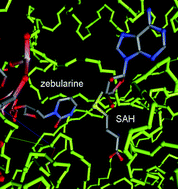This month sees the following articles in MedChemComm that are in the top ten most accessed:
2-Anilinonicotinyl linked 1,3,4-oxadiazole derivatives: Synthesis, antitumour activity and inhibition of tubulin polymerization
Ahmed Kamal, Y. V. V. Srikanth, Thokhir B. Shaik, M. Naseer A. Khan, Md. Ashraf, M. Kashi Reddy, K. Anil Kumar and Shasi V. Kalivendi
Med. Chem. Commun., 2011, 2, 819-823
DOI: 10.1039/C0MD00177E
Towards biocompatible nanovalves based on mesoporous silica nanoparticles
Ying-Wei Yang
Med. Chem. Commun., 2011, Advance Article
DOI: 10.1039/C1MD00158B
Minisci reactions: Versatile CH-functionalizations for medicinal chemists
Matthew A. J. Duncton
Med. Chem. Commun., 2011, Advance Article
DOI: 10.1039/C1MD00134E
Molecular obesity, potency and other addictions in drug discovery
Michael M. Hann
Med. Chem. Commun., 2011, 2, 349-355
DOI: 10.1039/C1MD00017A
Intramolecular hydrogen bonding to improve membrane permeability and absorption in beyond rule of five chemical space
Alexander Alex, David S. Millan, Manuel Perez, Florian Wakenhut and Gavin A. Whitlock
Med. Chem. Commun., 2011, 2, 669-674
DOI: 10.1039/C1MD00093D
The development of quinolone esters as novel antimalarial agents targeting the Plasmodium falciparum bc 1 protein complex
Robin Cowley, Suet Leung, Nicholas Fisher, Mohammed Al-Helal, Neil G. Berry, Alexandre S. Lawrenson, Raman Sharma, Alison E. Shone, Stephen A. Ward, Giancarlo A. Biagini and Paul M. O′Neill
Med. Chem. Commun., 2012, Advance Article
DOI: 10.1039/C1MD00183C
Designing glucokinase activators with reduced hypoglycemia risk: discovery of N,N-dimethyl-5-(2-methyl-6-((5-methylpyrazin-2-yl)-carbamoyl)benzofuran-4-yloxy)pyrimidine-2-carboxamide as a clinical candidate for the treatment of type 2 diabetes
Jeffrey A. Pfefferkorn, Angel Guzman-Perez, Peter J. Oates, John Litchfield, Gary Aspnes, Arindrajit Basak, John Benbow, Martin A. Berliner, Jianwei Bian, Chulho Choi, Kevin Freeman-Cook, Jeffrey W. Corbett, Mary Didiuk, Joshua R. Dunetz, Kevin J. Filipski, William M. Hungerford, Christopher S. Jones, Kapil Karki, Anthony Ling, Jian-Cheng Li, Leena Patel, Christian Perreault, Hud Risley, James Saenz, Wei Song, Meihua Tu, Robert Aiello, Karen Atkinson, Nicole Barucci, David Beebe, Patricia Bourassa, Francis Bourbounais, Anne M. Brodeur, Rena Burbey, Jing Chen, Theresa D’Aquila, David R. Derksen, Nahor Haddish-Berhane, Cong Huang, James Landro, Amanda Lee Lapworth, Margit MacDougall, David Perregaux, John Pettersen, Alan Robertson, Beijing Tan, Judith L. Treadway, Shenping Liu, Xiayang Qiu, John Knafels, Mark Ammirati, Xi Song, Paul DaSilva-Jardine, Spiros Liras, Laurel Sweet and Timothy P. Rolph
Med. Chem. Commun., 2011, 2, 828-839
DOI: 10.1039/c1md00116g
Discovery of CP-866,087, a mu opioid receptor antagonist for the treatment of alcohol abuse and dependence
Stanton F. McHardy, Steven D. Heck, Sara Guediche, Monica Kalman, Martin P. Allen, Meihua Tu, Dianne K. Bryce, Anne W. Schmidt, Michelle Vanase-Frawley, Ernesto Callegari, Shawn Doran, Nicholas J. Grahame, Stafford McLean and Spiros Liras
Med. Chem. Commun., 2011, 2, 1001-1005
DOI: 10.1039/C1MD00164G
Synthesis and evaluation of novel 5-sulfonyl-indolin-2-ones as potent cytotoxic agents
Yu Luo, Feng Xiao, Shijing Qian, Qiaojun He, Wei Lu and Bo Yang
Med. Chem. Commun., 2011, Advance Article
DOI: 10.1039/C1MD00105A
Design, synthesis and antiproliferative activity of urocanic-chalcone hybrid derivatives
Alexander Ciupa, Natalie J. Griffiths, Stephanie K. Light, Pauline J. Wood and Lorenzo Caggiano
Med. Chem. Commun., 2011, 2,1011-1015
DOI: 10.1039/C1MD00155H
Why not take a look at the articles today and blog your thoughts and comments below.
Fancy submitting an article to MedChemComm? Then why not submit to us today or alternatively email us your suggestions.
Comments Off on Top ten accessed articles in September



















 This mini-review from
This mini-review from